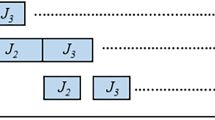Abstract
We develop a new dynamic programming method for the single item capacitated dynamic lot size model with non-negative demands and no backlogging. This approach builds the Optimal value function in piecewise linear segments. It works very well on the test problems, requiring less than 0.3 seconds to solve problems with 48 periods on a VAX 8600. Problems with the time horizon up to 768 periods are solved. Empirically, the computing effort increases only at a quadratic rate relative to the number of periods in the time horizon.
Similar content being viewed by others
References
Aggarwal, A. and J. K. Park (1990), Improved Algorithms for Economic Lot-Size Problem, Working paper, IBM Thomas J. Watson Research Center, Yorktown Heights, New York.
Baker, K. R., P. Dixon, M. J. Magazine, and E. A. Silver (1978), An algorithm for the Dynamic Lot-Size Problem with Time-Varying Production Capacity Constraints,Management Science 24, 1710–1720.
Barany, I., T. Van Roy, and L. A. Wolsey (1984a), Uncapacitated Lot-Sizing: the Convex Hull of Solutions,Mathematical Programming Study 22, 32–43.
Barany, I., T. Van Roy, and L. A. Wolsey (1984b), Strong Formulations for Multi-Item Capacitated Lot Sizing,Management Science 30, 1255–1261.
Bitran, G. R. and H. H. Yanasse (1982), Computational Complexity of the Capacitated Lot Size Problem,Management Science 28, 1174–1186.
Chen, H.-D. and C.-Y. Lee (1991), A Simple Algorithm for the Error Bound of the Dynamic Lot Size Model Allowing Speculative Motive, Research Report 91-5, Department of Industrial and Systems Engineering, University of Florida, Gainesville, Florida. (Revised for IIE Transactions)
Chung, C. S. and C. H. M. Lin (1988), AnOT 2 Algorithm for the NI/G/NI/ND Capacitated Lot Size Problem,Management Science 34, 420–426.
Chung, C.-S., J. Flynn, and C.-H. M. Lin (1990), An Efficient Algorithm for the Capacitated Lot Size Problem, Working paper, College of Business Administration, Cleveland State University, Cleveland, Ohio.
Federgruen, A. and M. Tzur (1991), A Simple Forward Algorithm to Solve General Dynamic Lot Sizing Models withn Periods inO(n logn) orO(n) Time,Management Science 37, 909–925.
Florian, M. and M. Klein (1971), Deterministic Production Planning with Concave Costs and Capacity Constraints,Management Science 18, 12–20.
Florian, M., J. K. Lenstra, and A. H. G. Lenstra (1980), Rinnooy Kan, Deterministic Production Planning Algorithm and Complexity,Management Science 26, 669–679.
Jagannathan, R. and M. R. Rao (1973), A Class of Deterministic Production Planning Problems,Management Science 19, 1295–1300.
Johnson, L. A. and D. C. Montgomery (1974),Operations Research in Production Planning, Scheduling, and Inventory Control, John Wiley and Sons, New York.
Kirca, Ö. (1990), An Efficient Algorithm for the Capacitated Single Item Dynamic Lot Size Problem,European Journal of Operational Research 45, 15–24.
Lambrecht M. and J. Vander Eechen (1978), A Capacity Constrainted Single-Facility Dynamic Lot-Size Model,European Journal of Operational Research 2, 132–136.
Leung, J. M. Y., T. L. Magnanti, and R. Vachani (1989), Facets and Algorithms for Capacitated Lot Sizing,Mathematical Programming 45, 331–359.
Love, S. F. (1973), Bounded Production and Inventory Models with Piecewise Concave Costs,Management Science 20, 313–318.
Pochet, Y. and L. A. Wolsey (1991), Solving Multi-Item Lot-Sizing Problems Using Strong Cutting Planes,Management Science 37, 53–67.
Silver, E. A. and R. Peterson (1985),Decision System for Inventory Management and Production Planning, John Wiley and Sons, Second Edition.
Sandbothe, R. A. and G. L. Thompson (1990), A Forward Algorithm for the Capacitated Lot Size Model with Stockouts,Operations Research 38, 474–486.
Swoveland, C. (1975), A Deterministic Multi-Period Production Planning Model with Piece-Wise Concave Production and Holding-Backorderer Costs,Management Science 21, 1007–1013.
Veinott, A. F., Jr. (1968), Extreme Points of Leontief Substitution Systems,Linear Algebra Applications 1, 181–194.
Wagelmans, A., S. Van Hoesel, and A. Kolen (1992), Economic Lot-Sizing: anO(n logn)-Algorithm that Runs in Linear Time in the Wagner-Whitin Case,Operations Research 40, S145-S156.
Wagner, H. M. and T. M. Whitin (1958), Dynamic Version of the Economic Lot Size Model,Management Science 5, 89–96.
Zangwill, W. (1966), A Deterministic Multi-Period Production Scheduling Model with Back-logging,Management Science 13, 105–119.
Author information
Authors and Affiliations
Additional information
This research was supported in part by NSF grants DDM-8814075 and DMC-8504786.
Rights and permissions
About this article
Cite this article
Chen, HD., Hearn, D.W. & Lee, CY. A new dynamic programming algorithm for the single item capacitated dynamic lot size model. J Glob Optim 4, 285–300 (1994). https://doi.org/10.1007/BF01098363
Received:
Accepted:
Issue Date:
DOI: https://doi.org/10.1007/BF01098363




